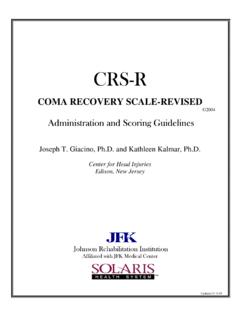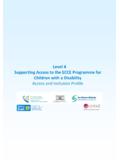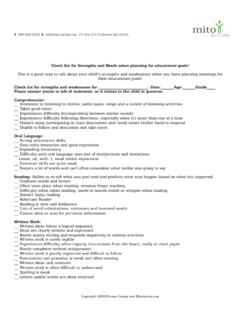Transcription of The Sensational Story of Sensory Processing and …
1 1 The Sensational Story of Sensory Processing and Behavior Presented by: Tara Maltby Compiled by: Lyda Baker, OTR/L Alaska Autism Resource Center Special Education Service Agency Making Sense of the Sensory Story in five parts Our 5 senses; and just a couple more .. Sensory Integration Sensory Processing Disorder Sensory Screening, Assessment and Evaluation Sensory Interventions Sensory Differences Sensory Processing is a persons way of noticing and responding to Sensory events in everyday life. We all perceive Sensory information differently. However, our students experience Sensory differences to a greater degree.
2 Students with impaired Sensory systems ( Sensory Processing disorders) who you may encounter at various sites include students with Attention Deficit Hyperactivity Disorder, Fetal Alcohol Spectrum Disorder, Intellectual Disability, Dyspraxia/Communication Disorders, Learning Disabilities, Emotional Disturbance, Autism Spectrum Disorder which includes high functioning Autism. Sensory Processing disorders may manifest into challenging behaviors in the classroom, which are commonly mistaken for non compliance, attention seeking, or escaping/avoiding a task. Many maladaptive behaviors (hitting, biting, screaming, slamming body against hard surfaces, self injurious behaviors) exhibited by students, particularly those with ASD serve the purpose of regulating their internal Sensory Processing systems.
3 2 Sensory Spectrum Not Sensitive Very Sensitive Seekers: Less sensitive/Active, seeking reflects high thresholds that need to be met through the surrounding environment, Seekers make noise, fidget, touch, feel, hang on others, and taste things. Low Registration (Under responders): Less sensitive/Passive, do not notice what is going on around them, may seem bored, dull, uninterested, difficult to engage, easily exhausted, appear apathetic. Sensitivity (Over responders): Very sensitive/Active, notice more things than their peers, easily upset, seem hyperactive, distracted, difficulty learning from experiences because their routine is often interupted.
4 Avoiding: Very sensitive/Passive, actively try to prevent Sensory input, experience discomfort quickly, develop rituals control their Sensory environment Objectives Understand the two hidden movement senses: vestibular and proprioception Gain a basic understanding of the components of Sensory integration Gain a basic understanding of Sensory Processing Disorder Identify signs of Sensory Processing Disorder Have a basic knowledge of Sensory Integration therapy and Sensory interventions 3 Our 5 senses; and just a couple more .. part one Our 5 Senses visual sight Ta c t i l e touch Gustatory taste Olfactory smell auditory sound + 2 more Proprioception body awareness Vestibular movement 4 Vestibular the movement sense up, down, angular, circular, fast, slow Vestibular System movement sense body movement, helps us plan our actions speed and direction if we are moving or still if things around us are moving or still like auditory .
5 Responds to vibrations Vestibular System movement sense helps with vision by stabilizing the eyes when our heads and bodies are moving tracking focusing 5 Vestibular System movement sense informs us of our relationship to gravity; if we are upright or upside down helps maintain our balance helps maintain posture and muscle tone -- the readiness of a muscle to work spinning tumbling wheeling circular & angular movement Merry-go-round vestibular and up and down back forth 6 unconscious awareness of our body helps create body scheme or body map tells us the relationship of our body parts to each other.
6 To other people and to objects adjusts the amount of muscle force needed for the given situation like the vestibular system it responds to movement and gravity Proprioception the sense of body awareness Proprioception the sense of body awareness joints muscles muscle spindles Heavy Work pushing pulling lifting position force 7 Our 7 senses Gustatory taste auditory sound visual sight Ta c t i l e touch Olfactory smell Proprioception body awareness Vestibular movement The Theory of Sensory Integration Dr. A. Jean Ayres, , OTR Dr. Ayres developed the theory in the 1950 s and 1960 s while practicing as an occupational therapist in a children s center, and then while earning her doctoral degree.
7 Part two Steps to Sensory Integration (SI) 1. Registration become aware of Sensory input 2. Orientation brain decides how to pay attention to input through modulation 3. Interpretation brain decides the quality of the input 4. Organization of a response is a response necessary; physical emotional, cognitive? 5. Execution of a response an action results, physical, emotional, cognitive 8 Sensory Integration/ Sensory Processing Person responds with an action, an emotion or a behavior Register Sensory information through the nervous system The brain modulates and interprets the input and organizes a response Outcomes of Sensory Integration Sensory Modulation How the brain regulates the Sensory input it receives and therefore regulates how we respond to Sensory information If information is too intense (loud concert)
8 It is inhibited or turned down in the brain If information is too mild (quiet speaker) it is facilitated or turned up in the brain 9 Modulation/Volume Control Tur n i t down too loud not important too low important, needs more attention Tur n i t up Two Types of Responses to Sensory Input Protective The Uh Oh! system alerts us fright, flight or fight reflexes Discriminative The Ah Ha. system determines big and subtle differences in what we are experiencing Neurotypical individuals with intact Sensory Processing have access to both systems; whereas individuals with Sensory Processing disorder respond in the protective mode most of the time.
9 Sensory Processing Disorder SPD part three 10 What causes Sensory Processing Disorder ? Not known for sure Atypical development of the nervous system Misfiring of information within the nervous system How Does SPD Affect Behavior? Problems with Motor Planning poor coordination, inconsistent motor performance, hard to learn new skills unsure of body position Problems with Response to Input flight, fright or fight at inappropriate times unable to determines differences and sameness Problems with Self Regulation over aroused, high activity level, hyper-vigilant easily distracted seeks Sensory input under-aroused, low activity level, passive avoids Sensory input Case Study Activity Listen to the descriptions of the different types SPD Find a partner (or two)
10 Read the descriptions of the three students with SPD Determine what type of SPD each of the students have based on the following information. 11 picky eater covers his ears when the other children get a little loud seems to like to tell the other children what to do doesn t like outdoor play gets upset easily, may even tantrum James dislikes play dough and finger painting FUSSY Tr o y when he falls or bumps himself he doesn t complain doesn t seem to be bothered by loud or sudden sounds responses are delayed likes circle time best when there is music and singing VERY QUIET PERSONALITY ACTION PA C K E D likes to spin, never gets dizzy can stay with an activity for at the a minute bumps into everybody and everything.




